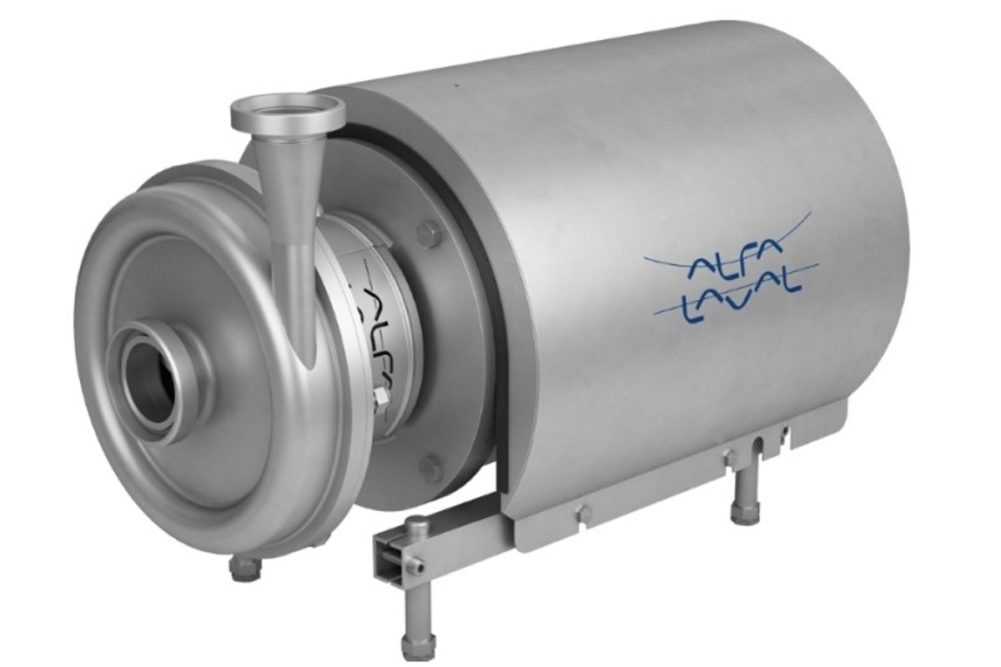With evolving consumer tastes, innovation is a necessity for dairy processors. This requires pump makers to work closely with customers to meet those changing demands. It also requires that the pumps themselves be more flexible to produce multiple products on a single process line.
Makers of pumps often tout their equipment as ‘gentle on products’, which refers to the amount of shear a pump inputs into a product, which is important because shear has the potential to change viscosity or other fluid properties. If there are particulates in the product, shear might reduce their size.
Higher-viscosity dairy products, such as cheese and yogurt, are sensitive to shear. Cheesemakers want a pump that can provide high flow rates yet also be gentle on the product in order to limit the fines produced when transferring the curd.
Centrifugal pumps
Typical dairy pumps are the centrifugal, liquid-ring and positive displacement (PD) pumps. The three types have different applications. The centrifugal pump is the type most widely used in dairy processing.
Centrifugal pumps are mainly used for low-viscosity products and cannot typically handle heavily-aerated liquids. These pumps have relatively high shear effect. They use a rotating impeller that accelerates the fluid as it enters the pump inlet and is forced to the outer impeller diameter before exiting through the discharge port or volute. These pumps are cost-effective and easily maintained, but their effectiveness is limited to lower viscosity fluids.
As the viscosity of the fluid increases, the efficiency of a centrifugal pump decreases significantly. Centrifugal pumps are used throughout the process to transfer low viscous fluid, typically milk, from one destination to another. In fluid milk plants, a low-speed (1,750 rpm) centrifugal pump is typically used due to high flow rates. This dramatically decreases the amount of shear exhibited on the product.
Alfa Laval, a global alliance partner of Tetra Pak, produces the LKH pump, which delivers energy efficiency and claims to be 30% more energy efficient than similar midrange pumps. The LKH pumps are used for evaporation, high-pressure, self-priming and high-purity applications. Alfa Laval SolidC focuses on initial cost and the self-priming MR pump, used for clean-in-place (CIP) return applications.
The AC, AC+, L Series, SP Series, M Series 3A-Certified line of centrifugal pumps from Ampco includes standard and heavy-duty, high pressure, self-priming and front-loading seals. The Ampco AC+ offers an improved shaft design, the first significant improvement in the traditional “C Series” style of pump. The LF Series line-up offers a front-loading seal option for ease-of maintenance.
Twin screw pumps
One big shift happening within dairy processing facilities is the use of twin screw pumps to provide greater flexibility. Like positive displacement pumps, twin screw pumps can be used for the gentle conveyance of lumpy, shear-sensitive and abrasive product. But they offer an added level of flexibility for pumping liquids of different viscosities. They are efficient with shearing product and can pump CIP solutions as well as they pump product.
Twin screw pumps can handle solids well without damaging them in inclusive products such as yogurt or ice cream with added fruits. They can be run at high speeds, allowing processors to run the products and increase the speed to run cleaning solutions through.
Fristam Pumps has developed the FDS twin screw pump, which offers easy maintenance with its frontloading seal and easy gearbox access design. The FDS can transport a range of products gently and reliably– from delicate cheese products, such as cottage cheese, ricotta, feta; shear sensitive cultured products like sour cream and yogurt, and large particles, including yogurt or ice cream mix with fruit inclusions.
GEA launched a twin screw pump as part of its Varipump line, which are pumps with a high degree of flexibility for optimum adaptation to individual customer requirements. The GEA Hilge Novatwin provides flexibility for a wide range of applications, with one pump by variable speeds up to 3,000 rpm.
Cleaning and Maintenance
For dairy processing facilities, pumps live as the heart of the operation. If one encounters a problem, production can come to a screeching halt.
Correct maintenance of pumps protects the reliability of the equipment. Plant managers need to work closely with their equipment manufacturers to determine maintenance intervals, which are based on the capabilities of pumps and values and on the process demands.
A preventative maintenance strategy can help optimize maintenance scheduling, including regular downtimes for maintenance, which can help in avoiding unexpected shutdown.
The plant manager can understand the rate of wear by making regular inspections of the equipment and taking the time to become familiar with the flow, pressure and noise levels of units when they are operating normally. This will enable equipment operators to be aware of any changes in these parameters. They can provide early warning of any potential issues.
Cleaning or sanitizing solution should be used at the correct flow rate, temperature and pressure for the application before a final rinse is carried out. Valves should be pulsed to make sure any residue under the seats is flushed away. Set the pulsing rate to the minimum to assure effective cleaning.
Manufacturers are striving not only to keep operations more hygienic and sanitary than ever, but they’re trying to keep uptime at a maximum, struggling to maintain profits and viability in an increasingly competitive market.

